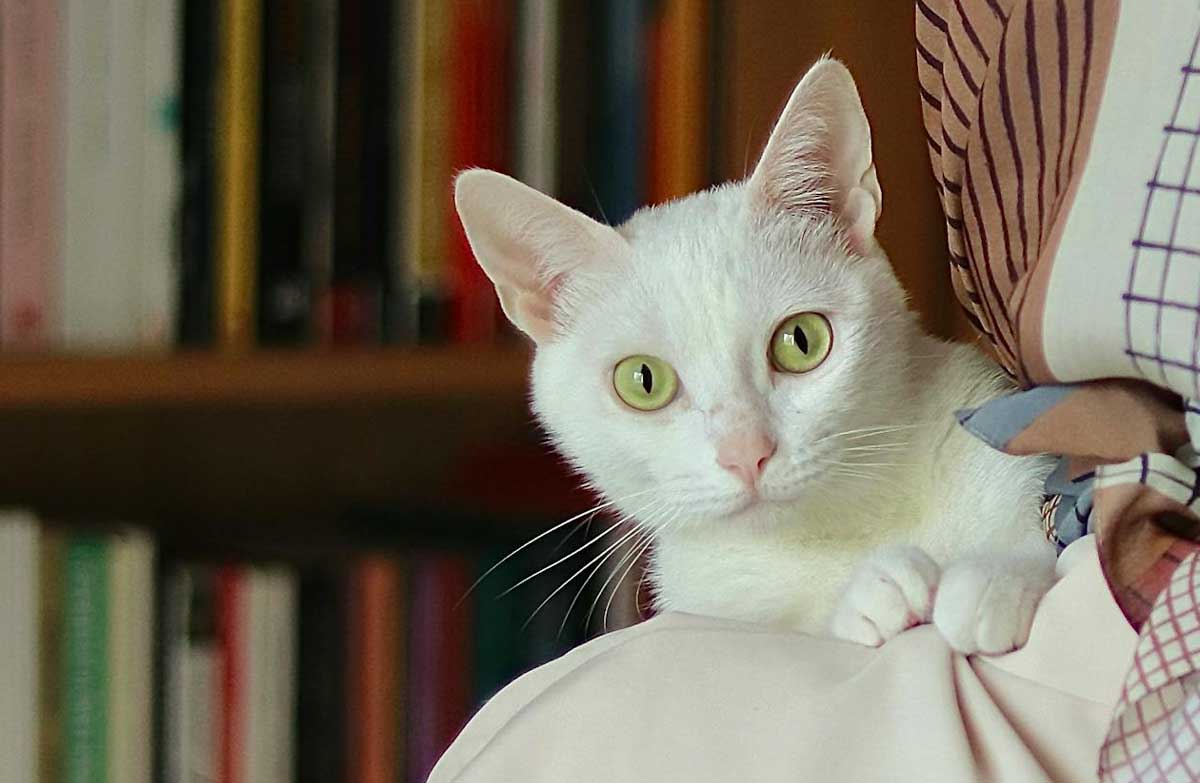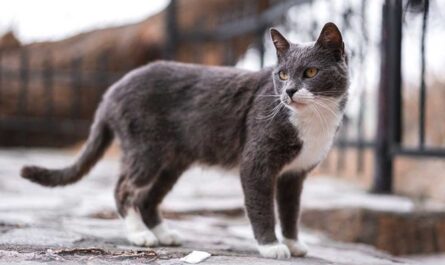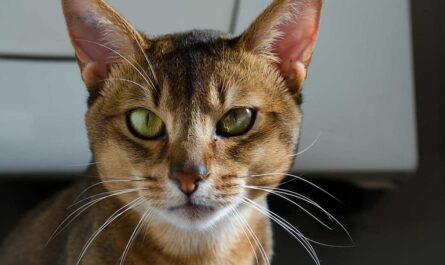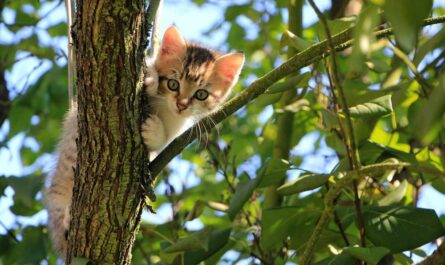Why does my cat sit on my shoulder? Have you ever been ambushed by a furry friend mid-conversation? One minute you’re engrossed in a chat, the next, a warm weight settles on your shoulder, accompanied by a rumbling purr and a pair of curious eyes gazing intently at the world from their newfound perch. This isn’t just a scene from a cat meme; it’s a real phenomenon known as “shoulder surfing,” and it can leave even the most devoted cat lover feeling a tad bewildered (and perhaps a little lopsided!).
But fear not, fellow feline fanciers! This article is here to crack the code behind your cat’s curious shoulder-sitting habit. By understanding the reasons why your furry acrobat seeks these lofty positions, you can navigate this unique behavior with confidence and maybe even a touch of amusement.
We’ll delve into the fascinating world of feline psychology, exploring the evolutionary instincts, territorial urges, and comfort-seeking desires that might be driving your cat’s skyward ambitions. We’ll also discuss the telltale signs that your feline friend is about to launch themselves onto your shoulder and offer some helpful strategies for managing this sometimes-adorable, sometimes-impractical behavior. So, grab a comfy seat (or perhaps a sturdy chair, just in case!), and let’s embark on a journey to understand the “why” behind the shoulder surfing phenomenon.
The Allure of the Apex: Decoding Feline Behavior
Cats are, by nature, born observers. Their keen senses and predatory instincts have instilled in them a deep desire for a good vantage point, a place where they can survey their domain and keep a watchful eye on their surroundings. Imagine your cat perched high on a bookshelf, tail swishing gently, as they scan the room for any sign of movement – a potential plaything, perhaps, or a particularly interesting dust bunny. This preference for high places has its roots in evolution. In the wild, ancestors of our domestic cats relied on climbing trees and other elevated positions to:
- Spot Prey: A higher vantage point allows a cat to see potential food sources from a distance, giving them a strategic advantage in the hunt.
- Avoid Danger: Being up high provides a better view of potential threats, allowing cats to escape predators or other dangers more easily.
- Survey Their Territory: From a higher perch, cats can keep an eye on their entire territory, ensuring their domain remains secure.
So, when your cat chooses your shoulder as their personal observation tower, it’s not just a random act of affection (although there might be some of that involved too!). They may see your shoulder as an extension of their preferred vertical world, offering them a temporary boost in height and a chance to observe the world from a new perspective.
There’s another interesting theory to consider: territorial marking. Cats are known for leaving their scent on objects and people they claim as their own. By rubbing against you or perching on your shoulder, your cat might be subtly (or not-so-subtly!) announcing to the world that you belong to them. After all, what better way to mark their territory than by becoming a living, purring cat throne?
The Signs: Decoding Your Cat’s Shoulder-Sitting Communication
Ever wondered what goes on inside your feline friend’s mind when they perch themselves regally on your shoulder? It turns out, a cat’s decision to choose your shoulder as their lookout point can be a window into their emotions and needs. By paying attention to their body language, vocalizations, and the frequency of their shoulder-surfing adventures, you can unlock the secrets behind this curious behavior.
Body Language: A Tale Told Without Words
The first step to deciphering your cat’s shoulder-sitting message is observing their body language. A relaxed kitty perched comfortably on your shoulder, eyes blinking contentedly, is likely enjoying the view and the closeness. Their body will be soft and loose, not tense or rigid. Imagine a furry little explorer perched on a mountain peak, surveying their domain with satisfaction.
However, a tense posture with flattened ears and a swishing tail might suggest your feline friend isn’t particularly thrilled about their high perch. This could be because they’re feeling overwhelmed by a loud noise or a new person in the house. In such cases, it’s best to gently lower them to the ground and offer them a quiet, familiar space to retreat to.
Purring Power: A Complex Symphony
Ah, the comforting rumble of a purring cat. We often associate purring with contentment, and it can be in this context too. A gentle purr, while your cat sits on your shoulder, can be a sign of pure happiness and affection. They’re enjoying your company and the warmth you radiate (cats love a good cuddle puddle!).
But here’s the thing – purring can also be a way for cats to self-soothe during stressful situations. So, if your cat starts purring intensely while perched on your shoulder during a thunderstorm, it might be their way of coping with the loud noises. Pay attention to the context and your cat’s overall demeanor to understand the true meaning behind the purr.
Frequency and Duration: A Pattern Emerges
The frequency and duration of your cat’s shoulder-sitting escapades can also offer valuable clues. A one-time hop onto your shoulder might simply be a fleeting moment of curiosity. But if your cat frequently chooses your shoulder as their prime real estate, it suggests they genuinely enjoy the experience.
Think about it – if your cat found the experience unpleasant or stressful, they wouldn’t keep coming back for more, right? So, a regular shoulder-sitting habit can be interpreted as a sign of trust and a desire for closeness.
By becoming a keen observer of your cat’s body language, purring patterns, and the frequency of their shoulder-sitting adventures, you’ll be well on your way to cracking the code of this fascinating feline behavior. The next time your furry friend chooses your shoulder as their throne, you’ll be able to understand the message they’re sending, loud and purrfectly clear.
Beyond the Perch: Exploring Why Your Cat Chooses Your Shoulder
Have you ever been ambushed by a furry friend who suddenly decides your shoulder is the perfect vantage point? While the sight of a cat perched contentedly on your shoulder can be undeniably adorable, it’s natural to wonder what motivates this curious behavior. Here, we’ll delve into the fascinating reasons behind your cat’s love for lofty shoulder real estate.
Craving Attention: A Shoulder Full of Affection
Cats are undeniably masters of communication, and sometimes, their chosen perches are a not-so-subtle way of conveying their desires. If your cat frequently chooses your shoulder, it might be their unique way of saying, “Hey there, human! How about some pets and cuddles?” After all, what better way to ensure they get a prime spot in your line of vision and a guaranteed dose of attention than by occupying your shoulder?
Imagine your cat perched regally on your shoulder, gazing expectantly into your eyes. This positioning not only puts them at eye level, but also makes them impossible to ignore! A gentle head nudge or a soft purr from this vantage point can melt even the most stoic heart. So, the next time your feline friend decides your shoulder is the place to be, consider it a furry invitation for some quality bonding time.
A Safe Harbor: Seeking Comfort and Security on Your Shoulder
Cats are creatures of habit who find comfort in routine and familiarity. Your scent, warmth, and steady heartbeat can be a source of security for your feline companion, especially during times of stress or uncertainty. Imagine a loud thunderstorm rattling the windows, or a new pet arriving in the house. In these situations, your cat might seek refuge on your shoulder, finding solace in your familiar presence.
Perching on your shoulder allows them to be close to you while still maintaining a good vantage point to survey their surroundings. It’s like having a personal bodyguard who also dispenses purrs and head bumps! So, the next time your cat chooses your shoulder during a stressful event, take it as a compliment – they clearly trust you as their haven.
Sharing Your Focus: A Bird’s-Eye View of What Interests You
Cats are naturally curious creatures, and they love to be involved in whatever you’re doing. If you find your cat frequently taking up residence on your shoulder while you’re working on the computer, reading a book, or even watching TV, it might be their way of staying close to the action. From their shoulder perch, they can get a bird’s-eye view of what has captured your attention.
Imagine yourself engrossed in a captivating documentary about exotic birds. Suddenly, you feel a familiar weight on your shoulder and a gentle nudge against your cheek. Your cat might simply be curious about the colorful creatures flitting across the screen, and your shoulder provides the perfect platform to share your focus. In this way, your cat can participate in your activities and stay connected with you, even if it means becoming a temporary shoulder accessory.
When the Perch Becomes a Problem: Managing Shoulder-Sitting Cats
Does your feline friend have an uncanny knack for transforming your shoulder into their personal lookout point? While their purrs might feel comforting at first, shoulder-sitting can become inconvenient and even unsafe. Here are some tips to gently guide your cat towards more appropriate perches:
Safety First: A Cat’s Castle Needs a Solid Foundation
Before embarking on any behavior modification, safety is paramount. Imagine your cat taking a tumble from your shoulder! Avoid situations where a sudden movement or loud noise could startle them, leading to a potential fall and injury.
Here are some safety precautions to consider:
- Be Aware of Your Surroundings: When carrying your cat, be mindful of doorways, furniture edges, and other potential hazards where a fall could occur.
- Keep Walks Short and Controlled: If you must carry your cat for short distances, use a secure carrier or harness to prevent them from leaping off your shoulder unexpectedly.
- Respect Their Limits: If your cat seems hesitant or nervous about being on your shoulder, don’t force it. Provide them with a safe and familiar landing spot nearby.
Once safety is assured, let’s explore some strategies to gently discourage shoulder-sitting:
Gentle Discouragement: Guiding Your Cat Towards More Suitable Heights
Cats are natural climbers, and their desire to be up high is deeply ingrained. The key is to offer them more appropriate outlets for this instinct. Here’s how:
- A Kingdom of Cat Trees: Invest in a sturdy cat tree with multiple levels, platforms, and scratching posts. This provides your cat with a dedicated climbing structure to satisfy their need for vertical space.
- Window Wonderlands: Cats are endlessly fascinated by the world outside. Secure window perches or shelves allow them to perch and observe their outdoor kingdom without resorting to your shoulder.
- Creative Cardboard Creations: Cardboard boxes are a feline favorite! Cut peepholes and stack them to create a climbing castle for your cat. Rotate the boxes regularly to maintain their interest.
Tip: When your cat attempts to climb onto your shoulder, gently redirect them toward one of their designated perches using a favorite toy or a treat. Positive reinforcement is key!
Positive Reinforcement: Rewarding the Right Moves
Positive reinforcement is a powerful tool for shaping your cat’s behavior. When your cat chooses to interact with you on the ground, playing with a toy or offering a tasty treat shows them that this is the preferred behavior.
Remember: Patience and consistency are key. Gradually, your cat will learn that there are more rewarding ways to connect with you than scaling your shoulders like Mount Everest.
By prioritizing safety, offering alternative climbing opportunities, and rewarding desirable behaviors, you can gently discourage your cat from using your shoulder as a personal throne.
Addressing Potential Issues: When to Seek Professional Help
Sometimes, a cat’s shoulder-sitting habit might be a sign of something more than just a quirky preference. Here are some situations where seeking professional help could be beneficial:
Stressful Triggers: Delving Deeper into the Meow-tivations
Cats are creatures of habit, and sudden changes in their environment or routine can trigger anxiety. If your cat’s shoulder-sitting behavior is a recent development, consider if there have been any changes at home that might be causing them stress, such as a new pet, a move, or a change in your schedule.
Seeking Professional Advice: If you suspect your cat’s shoulder-sitting is linked to anxiety, a qualified animal behaviorist can help you identify the source of stress and develop strategies to address it. They can also guide you in creating a more calming environment for your feline friend.
Sudden Onset: When a Change in Behavior Warrants Attention
A sudden change in your cat’s behavior, including the onset of shoulder-sitting, can sometimes indicate an underlying medical concern. This is especially true if the behavior is accompanied by other symptoms like lethargy, loss of appetite, or changes in litter box habits.
Consulting Your Veterinarian: Don’t hesitate to schedule a checkup with your veterinarian if your cat’s shoulder-sitting is a new development. Early diagnosis and treatment of any potential medical conditions are crucial for your cat’s well-being.
Aggressive Behavior: When Playtime Takes a Wrong Turn
While some cats may simply enjoy the vantage point a shoulder offers, others might use it as a way to assert dominance or feel more secure. If your cat exhibits any signs of aggression, such as hissing, swatting, or scratching, while on your shoulder, it’s important to seek professional help immediately.
Qualified Animal Behaviorist: An experienced animal behaviorist can assess the situation and develop a personalized training plan to address any aggressive tendencies. They can also teach you how to safely interact with your cat and prevent future incidents.
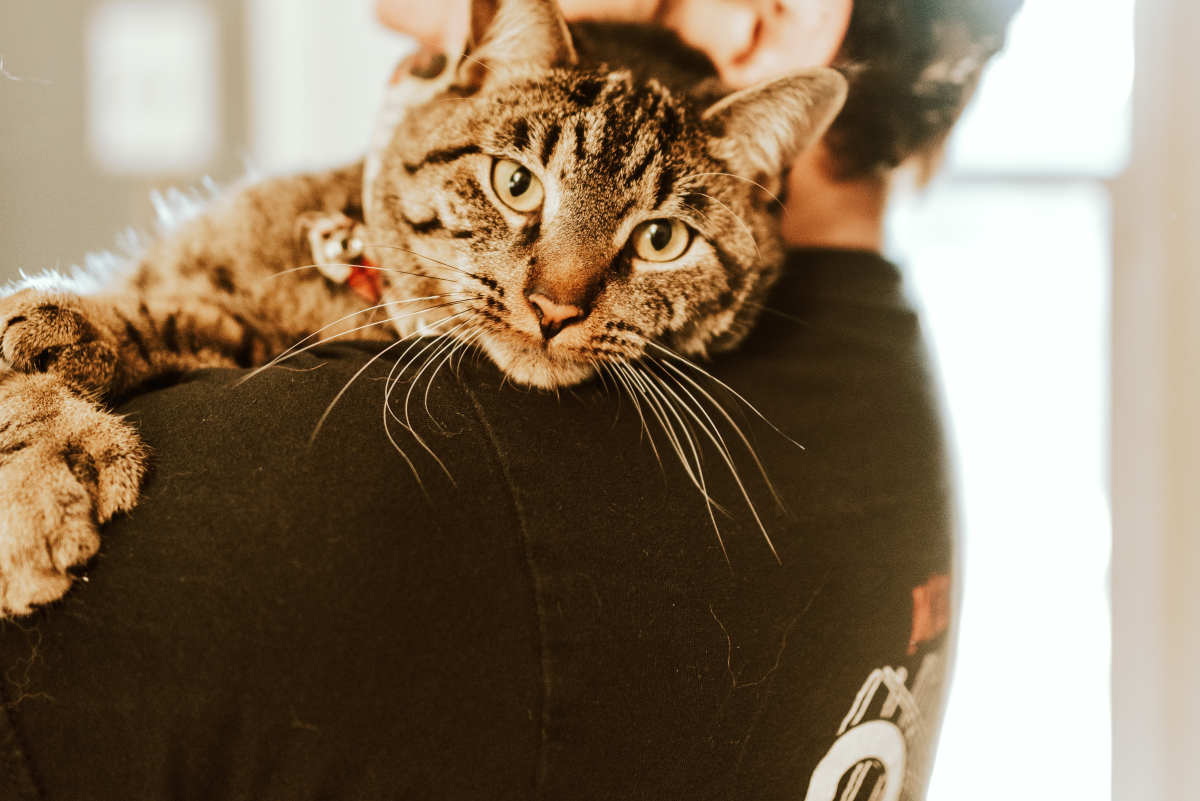
Case Studies: Decoding Your Cat’s Perch Preference – Why Your Shoulder is the New Cat Condo
Ever feel like your shoulder has become your cat’s personal throne? You’re not alone! Cats are notorious for their love of high places, and sometimes, that high place happens to be your unsuspecting shoulder. But what exactly is driving this behavior? Let’s delve into the fascinating world of feline perching preferences through some real-life case studies:
The Attention Seeker: A Shoulder Symphony of Demands
Meet Cleo: Cleo, a sleek Siamese with a captivating meow, has mastered the art of the shoulder-sit. The moment you enter the room, she winds her way around your legs, purring insistently, and before you know it, she’s perched proudly on your shoulder, demanding attention.
Decoding the Behavior: Cleo’s shoulder-sitting is likely a way to get your undivided attention. The higher vantage point puts her right in your face, making it hard to ignore her. How AI, ChatGPT maximizes earnings of many people in minutes
Strategies for Success:
- Reward the Right Behavior: Instead of giving Cleo attention when she jumps on your shoulder, try redirecting her with a fun play session or a cuddle when she approaches you calmly.
- Enrichment is Key: Provide Cleo with plenty of stimulating toys and climbing structures to keep her engaged and give her alternative outlets for attention-seeking behavior.
- Schedule Dedicated Playtime: Set aside regular times each day for interactive play sessions with Cleo. This will help her burn off energy and strengthen your bond.
The Security Blanket: A Shoulder Sanctuary During Stressful Times
Meet Oliver: Oliver, a fluffy Persian with a gentle soul, transforms into a shoulder-seeking missile whenever there’s a loud noise or an unfamiliar visitor. He scrambles up your leg, seeking solace and comfort on your shoulder.
Decoding the Behavior: Oliver’s shoulder-sitting is a way of self-soothing during stressful situations. The height and closeness to you provide him with a sense of security and protection. Motivation – Mind – Success – Thinking – Productivity – Happiness
Strategies for Success:
- Create a Safe Haven: Designate a quiet, cozy space for Oliver to retreat to during stressful times. This could be a cat bed tucked away in a closet or a designated “cat room” with familiar scents.
- Desensitization Techniques: If Oliver is particularly noise-sensitive, consider gradual desensitization therapy with the help of a veterinarian or animal behaviorist.
- Positive Reinforcement: Whenever Oliver displays calm behavior during potentially stressful situations, reward him with gentle praise or a tasty treat.
The Curious Climber: A Shoulder View of the World
Meet Luna: Luna, a playful tabby with boundless energy, loves nothing more than scaling any available surface, your shoulder included. From your shoulder, she can survey her entire kingdom, keeping a watchful eye on everything happening around her.
Decoding the Behavior: Luna’s shoulder-sitting is driven by her natural curiosity. The high vantage point allows her to see things she wouldn’t be able to see from the ground, keeping her entertained and engaged with her surroundings. Business – Money Making – Marketing – E-commerce
Strategies for Success:
- Vertical Playground: Create a vertical playground for Luna with cat trees, shelves mounted on the wall, or scratching posts with platforms. This will satisfy her desire to climb and provide her with her high vantage points.
- Rotate the Toys: Keep things interesting by rotating Luna’s toys regularly. New toys will pique her curiosity and encourage her to explore her vertical kingdom.
- Interactive Play: Engage Luna in interactive play sessions that encourage climbing and jumping behaviors, directing her curiosity toward her designated climbing structures.
By understanding the underlying motivations behind your cat’s shoulder-sitting habit, you can create a more enriching environment and establish training strategies that address their specific needs. Remember, a happy and stimulated cat is less likely to turn your shoulder into their personal perch!
Living with a Shoulder Surfer: Tips for a Harmonious Coexistence
Does your cat ever launch themselves onto your shoulder like a furry little acrobat? While this “shoulder surfing” behavior might be unexpected (and sometimes a bit startling!), it’s a fairly common feline fancy. But before you resign yourself to a life of permanent shoulder perches, there are ways to create a happy medium for both you and your climbing companion. Health books, guides, exercises, habits, Diets, and more
Building a Cat Paradise: Vertical Adventures Await!
Cats are natural climbers, and their urge to reach high places is deeply ingrained in their instincts. In the wild, their ancestors used elevated positions for hunting, surveying their territory, and keeping safe from predators. This innate desire to be “up high” translates to our homes as well.
The key to discouraging your cat from using your shoulder as her personal climbing frame is to provide her with plenty of alternative high places to explore. Here’s how:
- Cat Trees Galore: Invest in a sturdy cat tree with multiple levels, platforms, and scratching posts. The taller the better, as it allows your cat to indulge her climbing desires and observe her surroundings from a vantage point. Look for cat trees with different textures like sisal rope and plush surfaces to keep things interesting.
- Shelves for the Spirited Climber: Consider installing wall-mounted shelves specifically designed for cats. These create a designated “cat highway” around the room, allowing your feline friend to navigate your vertical space safely. Strategically place shelves near windows or sunny spots for extra lounging appeal.
- Scratching Post Extravaganza: Don’t underestimate the importance of scratching posts. These fulfill a biological need for cats to sharpen their claws and mark their territory. Provide a variety of scratching posts in different textures and heights to cater to your cat’s preferences. Fitness – Meditation – Diet – Weight Loss – Healthy Living – Yoga
By creating a stimulating vertical environment, you’ll give your cat her climbing kingdom, potentially reducing her reliance on your shoulder as a launchpad.
Interactive Playtime: Bonding and Burning Energy
Sometimes, a cat’s desire to perch on your shoulder stems from a lack of mental or physical stimulation. Regular interactive play sessions are a fantastic way to address this.
- Feathered Frenzy: Engage your cat with interactive toys like feather wands, catnip-filled mice, or laser pointers. These mimic prey and encourage your cat’s natural hunting instincts, providing a healthy outlet for her energy. Aim for short, invigorating play sessions several times a day.
- Puzzle Power: Food puzzles can be a great way to combine mealtime with mental stimulation. These toys require your cat to work for her food, keeping her occupied and engaged. Opt for puzzles with varying difficulty levels to keep things challenging and prevent boredom. RPM 3.0 – 60% CONVERSION & Money for Affiliate Marketing
- Rotation is Key: Just like humans, cats get bored with the same old toys. Rotate your cat’s toy collection regularly to keep her interest piqued. Introduce new toys every few weeks to maintain her enthusiasm for playtime.
By incorporating interactive play into your daily routine, you can help your cat expend energy and alleviate boredom, potentially reducing the urge to seek out your shoulder as a perch.
Respecting Choices: Understanding Your Cat’s Personality
It’s important to remember that every cat is an individual with a unique personality. For some cats, shoulder-sitting might be a genuine expression of affection and a way to bond with their human. If your cat seems content and relaxed while perched on your shoulder, and as long as it’s done safely (avoiding sudden movements or heights that could lead to falls), you might decide to allow it occasionally.
The key is to establish boundaries and ensure the behavior doesn’t become disruptive. For instance, you might discourage shoulder-sitting during specific times like cooking or when you need to focus on a task. Offer your cat alternative forms of affection like petting or grooming when she attempts to perch on your shoulder at inconvenient times. Cat accessories on Amazon
By providing a stimulating environment, engaging in playtime, and respecting your cat’s personality, you can create a harmonious coexistence, even with a shoulder-surfing feline friend.
Final thought: Celebrating the Bond and Embracing the Journey
The reasons behind your cat’s shoulder-surfing antics can be a combination of factors – a desire for a high vantage point, seeking attention, or simply expressing affection in their unique way. Understanding these motivations is key to building a strong bond with your feline companion.
The shoulder perch might be an unconventional form of cuddling, but ultimately, it reflects the special connection between you and your cat. Embrace the quirks and individual personalities that make cats so special. With a little patience, understanding, and the tips outlined above, you can navigate the shoulder-sitting behavior lovingly and respectfully, ensuring a happy and harmonious life for both you and your furry acrobat.
Other Interesting Articles
- How to Tell if Your Cat is in Pain after Surgery: How to Help
- How to Tell If Your Cat Loves You The Most: 23 Signs
- 20 Tips On How to Comfort A Scared and Frightened Cat
- 26 Signs Your Cat Can’t Breathe: A Guide to Help It Recover
- Cat Trilling Sound: What Does It Mean, How To Handle
- Cat Chattering Sound: What Does It Mean, How To Deal With
- How to Take Care of A Kitten 2 Months Old: Tips, Guide
- How to Feed A Newborn Kitten That Won’t Eat: 19 FAQs
- How to Care for Your Cat After Spaying or Neutering
- Cat Excessive Yowling: Why Cats Yowling: What You Can Do?
- How to Regain A Cat’s Trust after Hitting It: 16 Tips to Apply
- How to Tell If My Cat is in Pain after Spaying: How to Help
- How to Help Cats Get Along with Dogs: 17 Beginner’s Tips
- Keep Your Kids and Cats Safe: 15 Effective & Simple Tips
- How to Feed A Newborn Kitten: 30 Essential Tips for Beginners
- Do Cats Have Emotions Like Humans, Dogs? 10 Ways to Feel
- Petting A Scared Cat: 15 FAQs to Comfort A Fearful Cat
- 18 Implied Messages Your Cat Is Sending You With Its Tail
- How to Help Cats Get Along with Each Other: 14 Useful Tips
- 7 Causes of Cat Aggression: Biting, Fighting, Attacking
